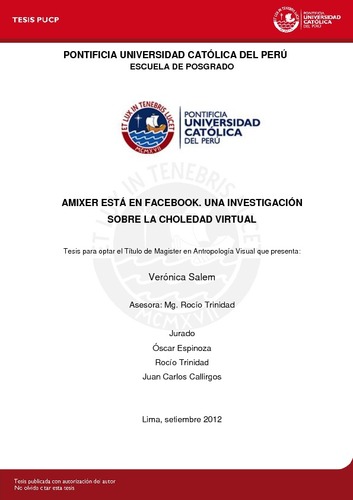| dc.contributor.advisor | Espinosa de Rivero, Oscar Alberto | |
| dc.contributor.advisor | Zapata, Rocío Trinidad | |
| dc.contributor.advisor | Callirgos Patroni, Juan Carlos | |
| dc.contributor.author | Salem, Verónica | es_ES |
| dc.date.accessioned | 2013-07-04T20:26:48Z | es_ES |
| dc.date.available | 2013-07-04T20:26:48Z | es_ES |
| dc.date.created | 2012 | es_ES |
| dc.date.issued | 2013-07-04 | es_ES |
| dc.identifier.uri | http://hdl.handle.net/20.500.12404/4643 | |
| dc.description.abstract | Una investigación que indaga en torno a la categoría discursiva “amixer”, y cómo se constituyen y despliegan las prácticas y discursos discriminatorios en las redes sociales virtuales, específicamente en Facebook. Es, entonces, una mirada a la red social virtual como una zona de debate o encuentro cultural; un escenario virtual de intercambio simbólico de múltiples vías, en el cual diversos actores sociales participan para negociar, resistir y consensuar su encuentro con Otros, con el fin principal de situarse, definirse y distinguirse, para mantener simbólicamente sus fronteras sociales. En este sentido, la ilusión ampliamente difundida por los medios de comunicación masiva de las redes sociales virtuales como espacios abiertos, libres y democráticos se complejiza al producirse procesos sociales imaginarios de privatización de espacios virtuales. Desde la plataforma tecnológica se articularon los procesos de debate y negociación de consensos colectivos para la identificación, categorización, definición y estereotipación de un nuevo sujeto discursivo que llegó a escena, con el objetivo de identificarlo y nombrarlo para ser detenido, en un intento por mantener vigentes fronteras simbólicas. Estas se presentan cada día como más borrosas e inestables debido al embate de fuertes cambios sociales, económicos, tecnológicos y geográficos ocurridos en el Perú contemporáneo, y que están marcados –principalmente– por el surgimiento de una nueva y amplia clase media y emergente. Como parte de estos procesos, se definieron y consensuaron rasgos de marcación social; se configuró una tipología; se recurrió a la memoria y a la cotidianidad, a la ironía, al insulto, a la parodia, al gusto y al chiste, a la vieja costumbre tan peruana de clasificar choleando, marcando con categorías inherentes a los discursos raciales. | es_ES |
| dc.description.abstract | This research project examines the term “amixer” as a discursive practice, and more broadly how practices and discourses are built and spread in virtual social networks, specifically on Facebook. It is, therefore, a look at the social network as an area of debate or cultural meeting; a virtual scenario of multiple-way symbolic exchange, in which diverse social factors take place to negotiate, resist and agree on their encounters with Others, with the main objective of placing, defining and distinguishing themselves, in order to symbolically maintain their social barriers. On that sense, the illusion of social networks as open, free and democratic spaces, widely spread by the massive media, becomes more complex. Focusing on the Peruvian use of Facebook, I argue that social networks have produced imaginary social processes of privatization of virtual spaces. The debates and the negotiation of collective consensus that took place on this technological platform around a new discursive subject (the ‘amixer’), intended its identification, categorization, definition and stereotypification with the sole objective of naming and situating it, in an attempt to stop its social mobility and keep current symbolic borders. Symbolic borders become blurrier and more unstable in contemporary Peru, where the strong social, economic, technological and geographic changes that took place since the late twentieth century gave place to the out coming of a new and broad middle and emerging class. As part of those processes, new traits of social status were defined and agreed on; a typology was configured; and memory and everydayness, irony, insult, parody, taste and jokes were used, as was the old and so Peruvian habit of classifying as “cholo”, in order to define subjects and their positions with intrinsic categories of an old racial discourse. | es_ES |
| dc.language.iso | spa | es_ES |
| dc.publisher | Pontificia Universidad Católica del Perú | es_ES |
| dc.rights | Atribución-NoComercial-SinDerivadas 2.5 Perú | * |
| dc.rights | info:eu-repo/semantics/openAccess | es_ES |
| dc.rights.uri | http://creativecommons.org/licenses/by-nc-nd/2.5/pe/ | * |
| dc.subject | Antropología visual. | es_ES |
| dc.subject | Facebook | es_ES |
| dc.subject | Racismo--Perú | es_ES |
| dc.subject | Discriminación--Perú. | es_ES |
| dc.subject | Redes sociales--Perú | es_ES |
| dc.title | Amixer está en facebook : una investigación sobre la choledad virtual | es_ES |
| dc.type | info:eu-repo/semantics/masterThesis | es_ES |
| thesis.degree.name | Magíster en Antropología Visual | es_ES |
| thesis.degree.level | Maestría | es_ES |
| thesis.degree.grantor | Pontificia Universidad Católica del Perú. Escuela de Posgrado | es_ES |
| thesis.degree.discipline | Antropología Visual | es_ES |
| renati.discipline | 315117 | es_ES |
| renati.level | https://purl.org/pe-repo/renati/level#maestro | es_ES |
| renati.type | http://purl.org/pe-repo/renati/type#tesis | es_ES |
| dc.publisher.country | PE | es_ES |
| dc.subject.ocde | https://purl.org/pe-repo/ocde/ford#5.04.03 | es_ES |






